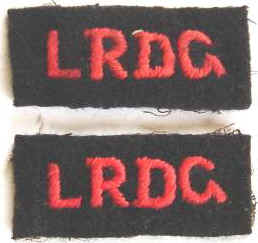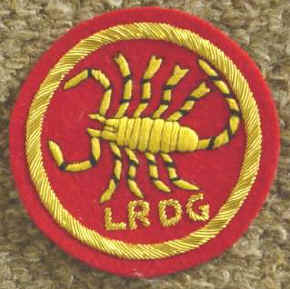|
Officialdom will tell you that the Long Range Desert Group has one badge, but we of the L.R.D.G. will say there are
two. What then is this unofficial badge ? And is it something they just dreamed up for themselves and does not count for much ? Quite the reverse: it is highly respected and very exclusive, and here is its background.
 |
Approval for such a unit was given to Major Ralph Bagnold, a mixture of soldier and scientist who had been involved in desert exploration for some years.
He immediately assembled about six officers with similar though somewhat lesser experience. For men, he turned to Australia, who wouldn't even listen.
He then came to New Zealand, who loaned him two subalterns and 85 other ranks.
<< Epaulette slides for
LRDG |
Long Range Patrol-yes, singular-was now in being, and this small group comprises the total entitlement of the "other" (which we call the L.R.P.) badge. It was a strictly controlled distribution, limited to one only per person, and the only exception I know of was the Imperial War Museum. The die was destroyed by L.R.P. personnel
themselves.
 |
<<< Blazer
badge of the LRDG Assoc.
Long Range Patrol was one small specialist unit, and was unconventional in many aspects. The most confusing (to historians, anyway) was that it simply divided itself into three parts for convenience, and called them R, T and W Patrols respectively.
These patrols operated either collectively or individually as required.
Misunderstanding arose after the spectacular successes of the first trip, -that is our term for an operation.
New Zealand, considering the men loaned for one job, wanted them back. |
Middle East Forces considered they
were loaned for a year (well, that's what they said) and asked for an extension of time. Reluctantly, New Zealand agreed, taking back only about 10 who were critically needed.
Middle East Forces immediately raised three completely new patrols. G Patrol from Guards Brigade, Y Patrol from Yeomanry Regiments, and S Patrol from the Rhodesian Brigade.
Add to these the veterans of the L.R.P. W Patrol had been disbanded due to casualties and the men taken back by New Zealand and those remaining were absorbed into the original R and T Patrols.
You now have the five patrols which comprise the L.R.D.G. But I hope it's clear that there
were R and T Patrols of the L.R.P. and R and T Patrols of the L.R.D.G., and that some men served with both.
The jeweler who made the badges offered some costume and personal jewellery to special order. Some of this will certainly exist in the case of both the L.R.P. and the L.R.D.G.
Names were painted on all trucks of R, T and S Patrols, but not those of G and Y. All New Zealand trucks bear Maori names. Rotomahana is an example for R Patrol, and of my own trucks TI was
Te Rangi, T2 Te Taniwha, and T6 Tutira,
The design of the badges was open to all and is a distillation of many suggestions. There is no one-off designer as such, but the late Cpl. C. 0. (Bluey)
Grimsey of Ngongotaha took most interest in marshalling ideas and suggestions so we very loosely ascribe the design to him.
The circle is primarily symbolic of a wheel, and secondarily of the application of the circle within astro-navigation-the celestial sphere of textbook
diagrams-and of free-ranging beneath it. It also symbolizes a number of partly-formed thoughts: universality of operation, unending
fulfillment or completion, eternity of freedom-these and similar implications were reduced to the simple unadorned circle. Popski did much the same thing when he settled on the astrolabe: being an engineer this would appeal to him. The scorpion is self-evident: a desert-dweller with a sting which can (occasionally, anyway) be fatal. No, it is not anatomically exact but that was the fault of the sketch supplied. The Cairo
jeweler had probably never ever seen one.
There is no official motto. Two suggestions were put forward: By Guile and Not By Strength, and Not By Strength But By Guile.
These nearly caused an explosion for there was no way that bureaucracy would countenance the word Guile. A hasty canvass was made for some sort of euphemism, but the best anyone could come up with (adroitness or dexterity) sounded a bit lame. I wanted to get away with it by translating it into Maori but there was no one handy to do this-they would never have known what the Maori was, of course. However, time was being wasted so the matter was dropped.
There are L.R.D.G. Associations in Britain and Rhodesia (only the postal
address is changed) as well as here. Our present membership is slightly under 200 nowadays. L.R.D.G. badges will exist in all three countries, but I think you can take about 300 badges as being a
very practical figure for the total within New Zealand.
We have indeed had spurious claims to membership, and, although we can not claim
laboratory exactitude (unconventional units have some degree of unconventional records) you can safely discount any membership we can't confirm. There are also borderline cases-what
would you say of one who arrived at lunchtime, made himself obnoxious, and was on his way back an hour after breakfast next day ?
I think you'll agree it's best to leave this sort of thing to us.
We sometimes use the terms Scorpion Badge for L.R.D.G. and Scarab Badge for the L.R.P. It should be understood this is merely a 'family slang' term. The badge has nothing to do with the dung-beetle or scarab.
from the journal of the New Zealand
Military Historical Society , December 1983.
|